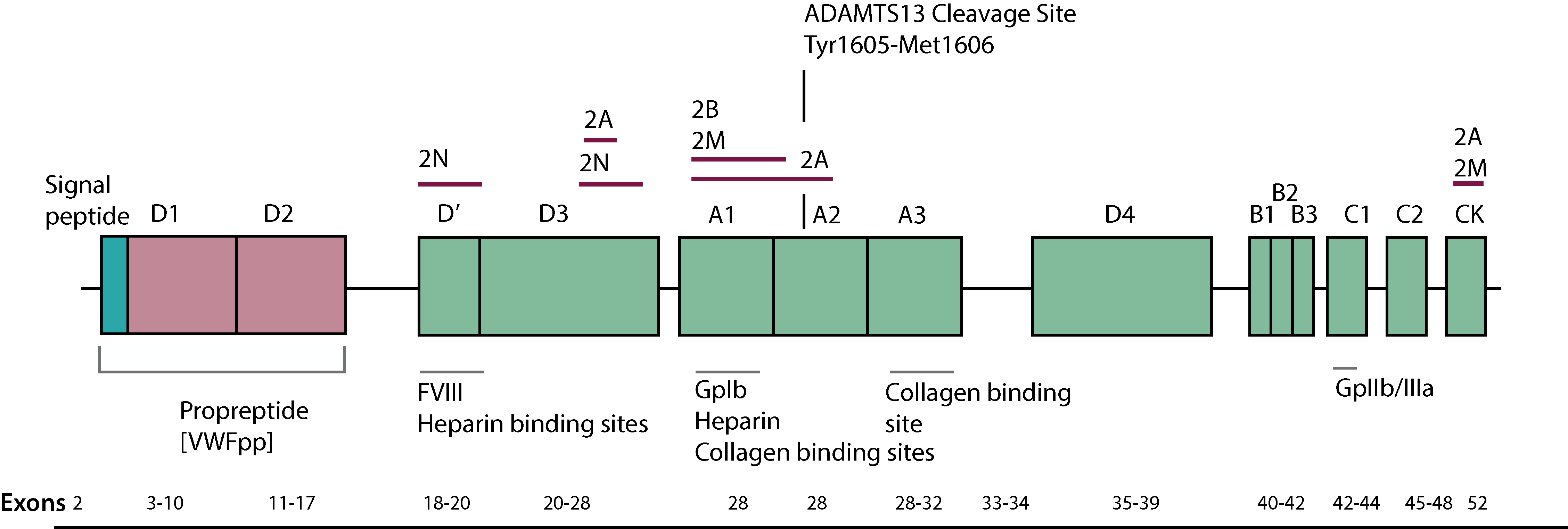Introduction
VWF is a large adhesive glycoprotein that functions as a carrier of Factor VIII and in addition is involved in the interaction of platelets with the vascular endothelium and in platelet-platelet interaction. VWF is synthesised as a protein of 2813 amino acids that includes a signal peptide of 22 amino acids, a prepropeptide of 741 amino acids [residues 23-763] and a mature protein of 2050 amino acids [residues 764-2813]. In the acidic compartment of the Golgi apparatus the pre-propeptide of VWF is separated from the mature VWF protein generating the VWF Propeptide [VWFpp] and the mature protein. Upon endothelial stimulation or damage, VWFpp together with VWF are secreted into the circulation.
The VWFpp has a concentration in plasma of 1 µg/ml and a half-life [T½] of 2-3 hours whereas the mature VWF protein has a concentration in plasma of 10 µg/ml and a T½ of 8-12 hours.

A novel mechanism for Type 1 VWD has been linked to an increased clearance of VWF from the plasma. Such individuals characteristically [with for example VWD Type IC Vicenza] show the classic bleeding symptoms of Type 1 VWD and the laboratory findings of a decreased VWF:Ag and VWF:RCo, reduced FVIII levels and a dominant mode of inheritance. Multimers in these patients may show the presence of ultra-large molecular weight multimers. DDAVP studies shows a significant increase in both FVIII and VWF levels but the proteins disappear rapidly from the plasma in contrast to other patients with Type 1 VWD who show a much slower clearance of FVIII and VWF from the plasma.
Principles & Method
The VWFpp assay is an ELISA assay in which VWFpp is captured using a specific monoclonal antibody and then detected using a separate anti-VWFpp antibody.
Interpretation
In individuals with Type 1 VWD due to accelerated clearance of the VWF protein from the plasma, the VWFpp to VWF:Ag ratio is increased and in the region of 4. This suggests that the VWFpp has a normal clearance and T½ but that the T½ of the mature VWF is decreased i.e. it is cleared more rapidly from the plasma due to a mutation within the mature VWF protein. Healthy individuals have a VWFpp to VWF:Ag ratio of 1.45 ± 0.06.
Type 1 VWD Vicenza [also known as Type 1C VWD] is associated with normal platelet VWF, plasma VWF levels of ~6-10 IU/dL and the presence of ultra-large plasma VWF multimers. The VWFpp/VWF antigen ratio is significantly increased in Type I Vicenza VWD and in the region of 13.02 +/- 0.49.
An increased VWFpp/VWF:Ag ratio is also seen in some patients with Type 2B, 2M and 2A VWD suggesting that these individuals also have an increased clearance of VWF from the plasma and which may in part contribute towards their phenotype.
The mechanism by which VWF clearance is accelerated is unclear but may be due to increased proteolysis of the VWF molecule by ADAMTS13. In Type 1 variants with accelerated clearance due to increased proteolysis by ADAMTS13 these are associated with the presence of smaller VWF multimers.
An increased VWFpp/VWF:Ag ratio is also seen in Acquired von Willebrand Syndrome [AVWS] reflecting an increased clearance of the mature VWF protein.
Reference Ranges
The range for VWFpp varies with blood group but is only significant when comparing blood group O to non-blood group O. The reference range for VWFpp is in the region of 55-219 U/dL with an average of value of ~118 U/dL. The ratio of VWFpp to VWF:Ag can also be calculated and is in the region of 1.26±0.36 close to the expected value of 1.0.
What Test Next
In individuals with an abnormal VWFpp:VWF:Ag ratio suggesting a Type 1 VWD with accelerated clearance, molecular studies may be of value. Similarly DDAVP studies can be useful in establishing the nature of this variant protein. In such cases patients show a rapid rise in VWF and FVIII:C following DDAVP but there is a rapid fall in levels compared to the majority of patients with Type 1 VWD.
